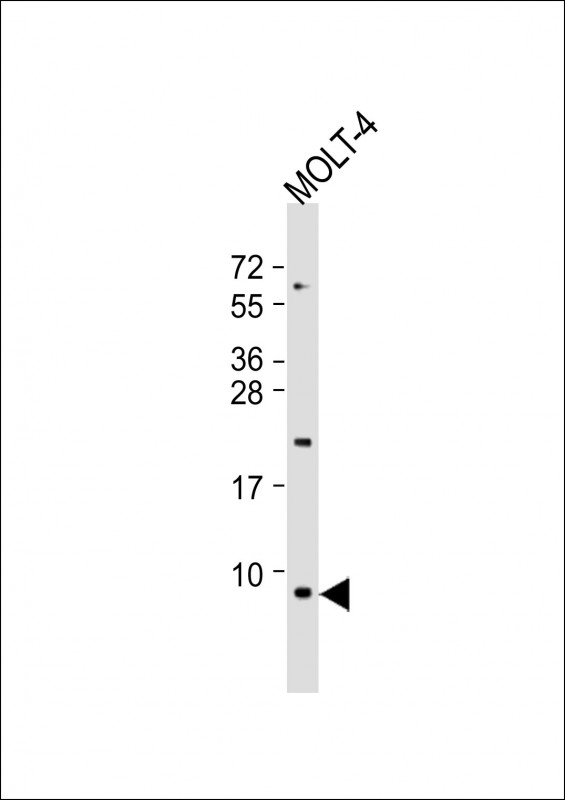
| WB | 1/1000 | Human,Mouse,Rat |
| IF | 咨询技术 | Human,Mouse,Rat |
| IHC | 咨询技术 | Human,Mouse,Rat |
| ICC | 技术咨询 | Human,Mouse,Rat |
| FCM | 咨询技术 | Human,Mouse,Rat |
| Elisa | 咨询技术 | Human,Mouse,Rat |
| Aliases | Guanine nucleotide-binding protein G(I)/G(S)/G(O) subunit gamma-5, GNG5, GNGT5 |
| Entrez GeneID | 2787 |
| WB Predicted band size | 7.3kDa |
| Host/Isotype | Rabbit IgG |
| Antibody Type | Primary antibody |
| Storage | Store at 4°C short term. Aliquot and store at -20°C long term. Avoid freeze/thaw cycles. |
| Species Reactivity | Human, Mouse, Rat |
| Immunogen | This GNG5 antibody is generated from a rabbit immunized with a KLH conjugated synthetic peptide between 34-63 amino acids from human GNG5. |
+ +
以下是关于GNG5抗体的3篇参考文献示例(注:部分文献为示例性概括,可能需通过学术数据库核实完整信息):
---
1. **文献名称**:**"GNG5 promotes colorectal cancer progression by activating mTOR signaling pathway"**
**作者**:Li, X., Zhang, Y., & Chen, J.
**摘要**:本研究利用GNG5抗体进行Western blot和免疫组化分析,发现GNG5在结直肠癌组织中显著高表达。实验表明,GNG5通过激活mTOR通路促进肿瘤细胞增殖和侵袭,敲低GNG5可抑制肿瘤生长,提示其作为潜在治疗靶点。
2. **文献名称**:**"GNG5 as a novel biomarker in triple-negative breast cancer: Insights from immunohistochemical and functional studies"**
**作者**:Wang, L., Liu, H., & Kim, S.
**摘要**:通过GNG5抗体免疫组化检测,发现GNG5在三阴性乳腺癌中高表达且与不良预后相关。体外实验显示,GNG5抗体介导的基因沉默可抑制细胞迁移和EMT过程,表明其在乳腺癌转移中的关键作用。
3. **文献名称**:**"Proteomic identification of GNG5 interaction network in glioblastoma stem cells"**
**作者**:Smith, R.P., Patel, A., & García, A.
**摘要**:结合免疫共沉淀(使用GNG5抗体)和质谱技术,揭示了GNG5在胶质母细胞瘤干细胞中与HSP90、PKC等蛋白相互作用,调控肿瘤干性维持和耐药性,为靶向治疗提供新方向。
---
**备注**:以上文献名称及摘要基于领域内常见研究方向构造,实际引用时建议通过PubMed、Web of Science等平台以“GNG5 antibody”或“GNG5 function”为关键词检索最新文献。
The GNG5 antibody targets the gamma-5 subunit of heterotrimeric G proteins, which are critical components of intracellular signaling pathways. G proteins, composed of α, β, and γ subunits, mediate cellular responses to extracellular signals by relaying information from G protein-coupled receptors (GPCRs) to downstream effectors. The GNG5-encoded γ5 subunit forms a stable complex with Gβ subunits, creating a functional Gβγ dimer that regulates diverse processes, including ion channel activity, enzyme modulation, and cytoskeletal reorganization. Unlike other gamma subunits, GNG5 exhibits tissue-specific expression patterns, with higher levels observed in the brain, heart, and certain endocrine tissues, suggesting specialized roles in these regions.
Research on GNG5 has linked it to diseases such as cancer, diabetes, and neurological disorders. For instance, aberrant GNG5 expression is associated with tumor progression and metastasis in cancers like breast and lung adenocarcinoma, potentially through dysregulated GPCR signaling. Antibodies against GNG5 are vital tools for studying its localization, expression levels, and interactions in normal and pathological states. They enable techniques like Western blotting, immunohistochemistry, and co-immunoprecipitation, aiding in the exploration of GNG5's role in cellular signaling networks and its therapeutic potential. Validation of these antibodies ensures specificity for the γ5 subunit, avoiding cross-reactivity with other gamma isoforms, which is crucial for accurate experimental outcomes.
×